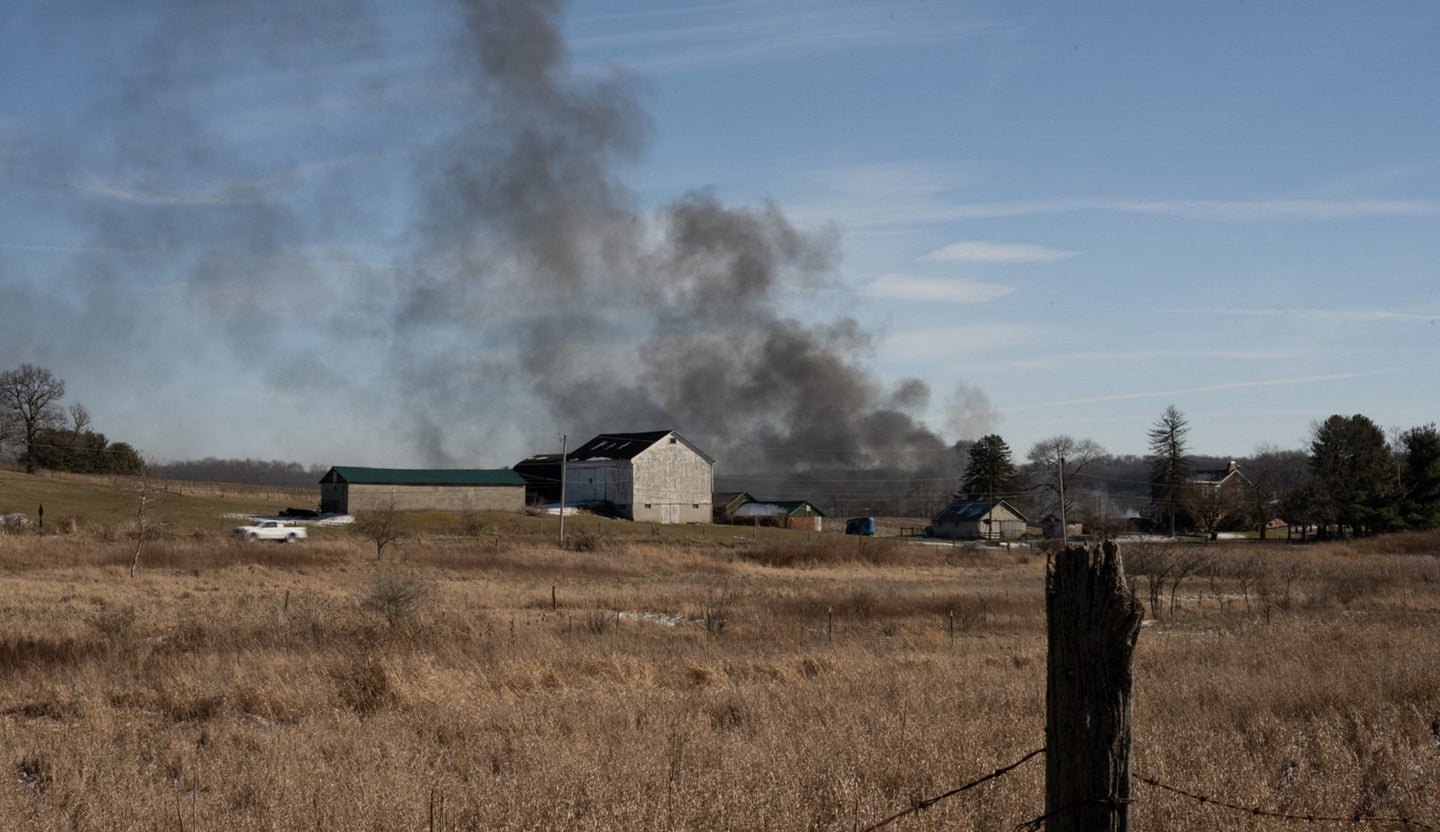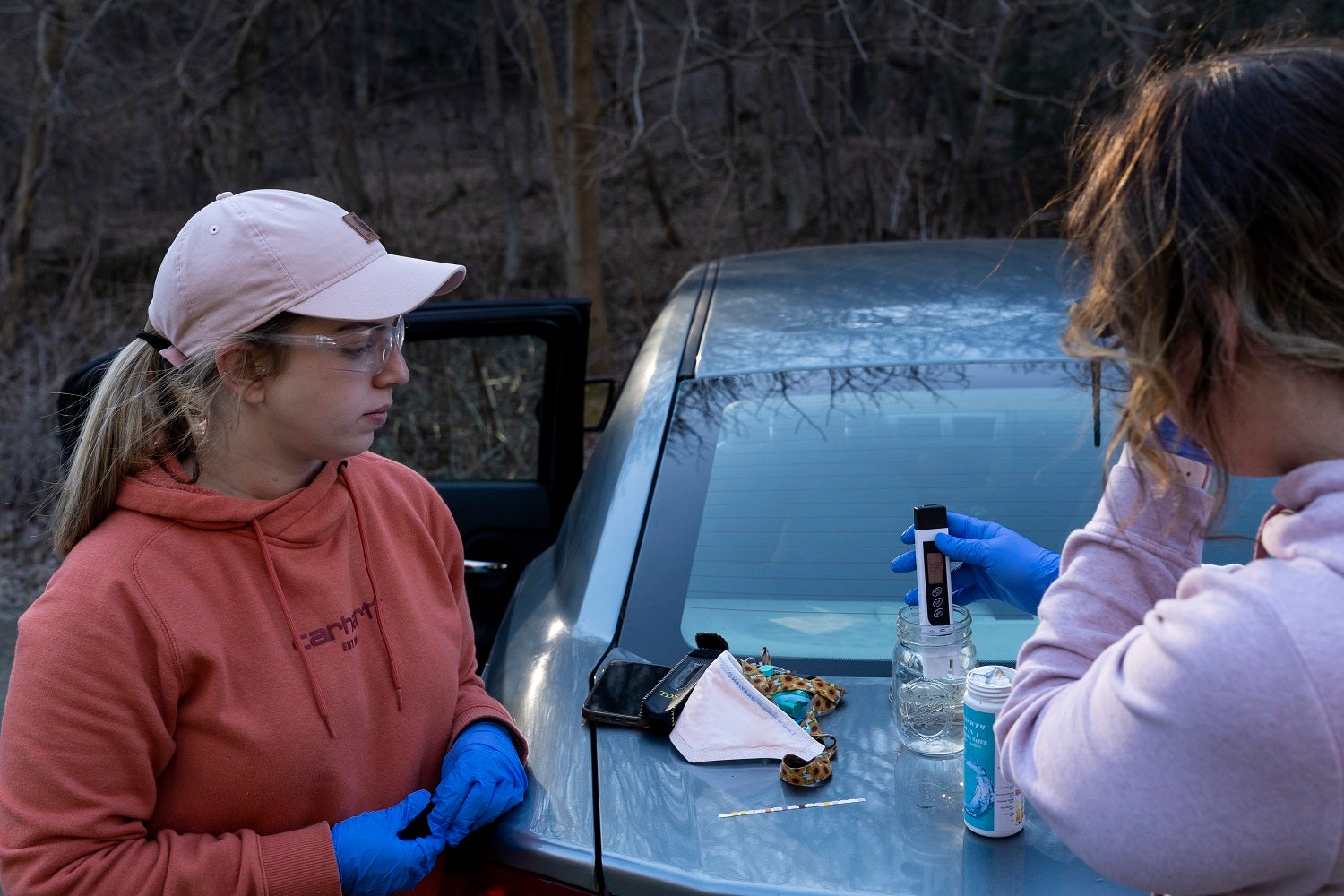
Nearly a month after a train derailment in Ohio caused a toxic chemicals spill, the roughly 5,000 residents of East Palestine are worried about whether the air is safe to breathe. Since the accident, locals have complained of headaches, rashes, and a lingering smell in the air resembling “hair perming solution,” along with respiratory issues like chronic coughing, wheezing, and acute bronchitis, possibly from chemical irritants inflaming their airways. And now the concern has spread to people in other states.
Social media users living hundreds of miles away are posting videos showing alleged signs of acid rain and attributing it to air pollutants traveling from Ohio. There are also videos of individuals in other states saying they’re experiencing nausea and a burning sensation in their throats and noses due to a strong chemical odor in the rain. Some TikTokers have also attempted to explain how vinyl chloride, one of the main chemicals in the spill, is causing acid rain outside of East Palestine.
[Related on PopSci+: Dust clouds are killing people out West—and the dangers could spread]
Are their fears of traveling toxins justified? “Given the [high] amount of chemicals that were involved and the controlled conversion, I don’t think it’s a major issue for [people living] long-distance,” says Oladele Ogunseitan, a professor of population health and disease prevention at the University of California, Irvine. “I’m not saying it’s an absolute no because we don’t fully understand all the moving parts, but it’s just an infinitesimal chance.”
First, what is acid rain?
Acid rain is any form of precipitation where water and oxygen react with nitrogen oxide and sulfur dioxide to form acidic compounds. While natural causes such as volcanic eruptions can release these chemicals, most acid rain events result from human activity, such as burning coal and other sulfur-containing compounds.
Pure water has a neutral pH of 7, with regular rainfall being slightly more acidic with a pH of less than 6. Acid rain, however, usually falls between a range of 5 to 5.5 on the pH scale, meaning it’s more corrosive.
Though making contact with acid rain won’t burn your skin off, you might experience irritation in your eyes, throat, and nose. The bigger issue is inhaling the chemical compounds in acid rain. The longer you spend time in acid rain, the likelier it is that pollutants will enter your lungs. Depending on how long you’re exposed and how many particles you inhale, acid rain can cause several long-term health problems, ranging from asthma and chronic bronchitis to heart attacks if you have a history of cardiac issues.
Can vinyl chloride cause acid rain?
In Ohio, officials decided on a “controlled release” after a temperature change in the five derailed train cars carrying vinyl chloride prompted worry about a possible larger explosion. Vinyl chloride—a synthetic, carcinogenic chemical used to make plastic for pipes, wire coatings, and car parts—was released in liquid form before being set ablaze for days in a barricaded area. Burning it breaks it down into hydrogen chloride, carbon monoxide, carbon dioxide, and a toxic gas called phosphene.
And while burning vinyl chloride can also produce hydrochloric acid, a component of acid rain, it would have been immediately seen at the site at the time of the controlled chemical release. Right now there are some “pretty bad smells” in East Palestine, says Peter DeCarlo, an associate professor of environmental health and engineering at Johns Hopkins University, but not as much air pollution as there was on the first day. If the derailment was causing widespread acid rain, locals would experience it first.

What’s the current air pollution forecast in East Palestine?
After screening 578 homes in East Palestine over the past few weeks, the Environmental Protection Agency reported that outdoor air quality in the residential area was normal and continued to assert that there are no health risks. Some environmental scientists, however, are skeptical of the clean-cut assessment.
“What would prove if the place is habitable is if nobody gets sick, but we know people are having symptoms,” says Ogunseitan. A separate group of environmental researchers at Texas A&M University conducted their own air sample analysis in the town’s streets. In a Twitter thread posted last Friday, they shared that nine of the 50 chemicals identified by the EPA are at higher-than-normal levels.
[Related: Breathe easier during wildfires with a DIY air purifier]
While the research is ongoing, the Texas A&M team warns of a potential health concern if levels of chemicals such as acrolein stay elevated. Acrolein can cause irritation in the skin, eyes, and mucous membranes. When inhaled, the suffocating odor may trigger respiratory distress and dizziness.
Ogunseitan doesn’t think locals need to evacuate again based on this initial study, but does say it should raise the alarm for continuous air monitoring and health screenings for residents. He points out that some people might be more sensitive to even the smallest amount of exposure to toxic chemicals, so solution is to “identify those who are particularly vulnerable to these levels of chemicals and have them temporarily move.”
Is there any chance the chemicals will reach other states?
Based on the EPA’s air emission models on wind direction, rainfall, and the natural settling of dust and smoke from the derailment site, Ogunseitan says the data doesn’t support pollutants traveling as far as the East and West Coasts. When an incident like this happens, he notes there’s always a level of mass hysteria that has people blaming the incident for something unrelated.
On the very slim possibility of pollutants wafting outside the East Palestine area, DeCarlo says his biggest concern would be for anyone living just across the border in Pennsylvania because of close proximity to the accident. “As you move away from the site, the emissions from the fire become diluted and less concentrated,” he explains. “For people living several states away, this will not be the same type of issue as those in the immediate area.”
The post Is acid rain forming from the Ohio train derailment site? appeared first on Popular Science.
Articles may contain affiliate links which enable us to share in the revenue of any purchases made.
from Popular Science https://ift.tt/uKeA5SR




0 Comments